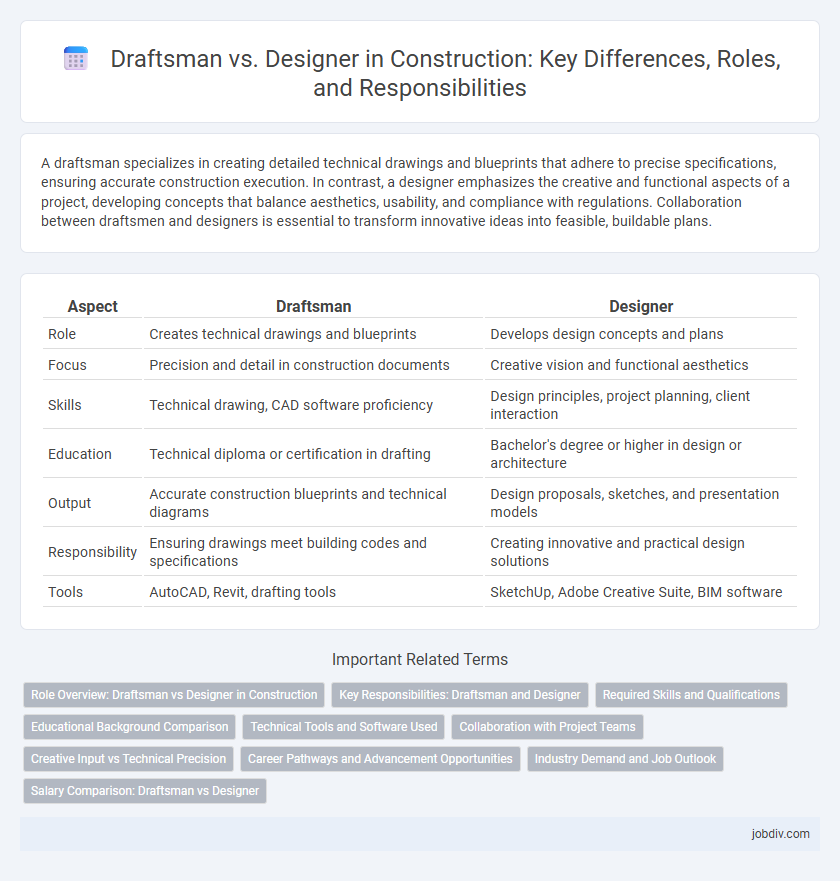A draftsman specializes in creating detailed technical drawings and blueprints that adhere to precise specifications, ensuring accurate construction execution. In contrast, a designer emphasizes the creative and functional aspects of a project, developing concepts that balance aesthetics, usability, and compliance with regulations. Collaboration between draftsmen and designers is essential to transform innovative ideas into feasible, buildable plans.
Table of Comparison
| Aspect | Draftsman | Designer |
|---|---|---|
| Role | Creates technical drawings and blueprints | Develops design concepts and plans |
| Focus | Precision and detail in construction documents | Creative vision and functional aesthetics |
| Skills | Technical drawing, CAD software proficiency | Design principles, project planning, client interaction |
| Education | Technical diploma or certification in drafting | Bachelor's degree or higher in design or architecture |
| Output | Accurate construction blueprints and technical diagrams | Design proposals, sketches, and presentation models |
| Responsibility | Ensuring drawings meet building codes and specifications | Creating innovative and practical design solutions |
| Tools | AutoCAD, Revit, drafting tools | SketchUp, Adobe Creative Suite, BIM software |
Role Overview: Draftsman vs Designer in Construction
A draftsman in construction primarily focuses on creating detailed technical drawings and blueprints based on architectural plans, ensuring precision and adherence to specifications. Designers are responsible for conceptualizing and developing the overall aesthetic and functional aspects of a project, integrating creativity with technical requirements. While draftsmen translate design visions into practical schematics, designers shape the vision, balancing client needs with construction feasibility.
Key Responsibilities: Draftsman and Designer
Draftsmen create precise technical drawings and blueprints using CAD software, ensuring accurate dimensions and compliance with building codes. Designers develop conceptual plans and aesthetic layouts, integrating client requirements with structural feasibility and material selection. Both roles collaborate to translate design visions into practical construction documents.
Required Skills and Qualifications
Draftsmen require proficiency in technical drawing software such as AutoCAD and a strong understanding of construction blueprints, material specifications, and industry standards. Designers need advanced skills in 3D modeling, creative design principles, and knowledge of building codes, structural integrity, and sustainable materials. Both roles demand attention to detail, excellent spatial awareness, and relevant certifications like a diploma in drafting or a degree in architectural design.
Educational Background Comparison
Draftsmen typically hold technical diplomas or associate degrees in drafting or CAD (Computer-Aided Design) programs, focusing on precise technical drawing skills and software proficiency. Designers often possess bachelor's degrees in architecture, interior design, or civil engineering, emphasizing creative problem-solving, design principles, and project conceptualization. The educational path for designers integrates advanced theoretical knowledge with artistic elements, whereas draftsmen concentrate on practical, detail-oriented training aligned with construction documentation.
Technical Tools and Software Used
Draftsmen primarily use Computer-Aided Design (CAD) software such as AutoCAD and MicroStation to create precise technical drawings and blueprints essential for construction projects. Designers often employ more versatile design software like Revit and SketchUp, which integrate 3D modeling and BIM (Building Information Modeling) capabilities to conceptualize and visualize entire structures. The technical tools used by draftsmen emphasize accuracy in detailing, while designers focus on creative visualization and project coordination through advanced software solutions.
Collaboration with Project Teams
Draftsmen and designers play complementary roles in construction project teams, with draftsmen primarily producing detailed technical drawings and designers focusing on conceptual planning and aesthetics. Effective collaboration involves draftsmen translating designers' creative visions into precise blueprints that engineers and contractors can implement. Seamless communication between both roles enhances project accuracy, reduces errors, and ensures timely progression from design to construction stages.
Creative Input vs Technical Precision
Draftsmen prioritize technical precision by producing detailed architectural drawings and blueprints essential for accurate construction. Designers contribute creative input by conceptualizing innovative layouts, aesthetics, and functional spaces that shape the overall vision of a project. The collaboration between draftsmen and designers ensures that creative concepts are effectively translated into technically sound construction plans.
Career Pathways and Advancement Opportunities
Draftsmen primarily focus on creating detailed technical drawings and plans, serving as vital support in the construction process, while designers develop conceptual ideas and overall project aesthetics, impacting design strategy and client presentations. Career pathways for draftsmen often lead toward roles like CAD technician, BIM specialist, or project coordinator, emphasizing technical proficiency and detail orientation. Designers typically advance to positions such as lead designer, project manager, or creative director, where creative vision and leadership drive project innovation and business growth.
Industry Demand and Job Outlook
The construction industry shows a growing demand for both draftsmen and designers, driven by increasing infrastructure projects and urban development. Draftsmen are sought for their expertise in creating precise technical drawings using CAD software, while designers are valued for their creative skills in conceptualizing building aesthetics. Projected job growth for designers is higher due to the expanding emphasis on sustainable and innovative architectural solutions.
Salary Comparison: Draftsman vs Designer
Draftsmen typically earn an average annual salary ranging from $40,000 to $60,000, depending on experience and location, while designers in construction can see salaries from $55,000 to $85,000 or higher due to broader creative responsibilities and project management roles. Salary differences between draftsmen and designers reflect the level of expertise, with designers often requiring advanced skills in software and design principles. Geographic factors and industry demand also significantly impact compensation, with urban construction hubs offering higher wages for both professions.
Draftsman vs Designer Infographic

 jobdiv.com
jobdiv.com